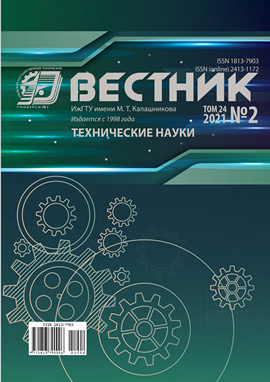Интеграция технологии InSAR в оценке устойчивости конструкций
DOI:
https://doi.org/10.22213/2413-1172-2021-2-60-67Ключевые слова:
гражданское строительство, структурный мониторинг, неразрушающий контрольАннотация
Неразрушающий контроль зданий и сооружений является актуальной проблемой в современном строительстве. Несмотря на то, что за последние десятилетия было разработано много измерительных методов, все же остаются некоторые пробелы в системе оценки состояния зданий и сооружений. Одна из основных проблем заключается в том, что измеряемые параметры оцениваются лишь время от времени. Существует ограниченное количество доступных методов, которые могут обеспечить непрерывный мониторинг технического состояния строительных сооружений и предоставить информацию об их устойчивости во временном ряду. Основная цель данной статьи - представить диагностический метод, который может преодолеть упомянутые недостатки, сочетая периодические неразрушающие измерения с непрерывным мониторингом, получаемым путем применения спутникового дистанционного зондирования. Радар с синтезированной апертурой (SAR) имеет много преимуществ, которые стоит учитывать инженерам-строителям в практике оценки устойчивости зданий и сооружений. Наша задача - дать представление о теории интерферометрических радаров с синтезированной апертурой (InSAR) и продемонстрировать их совместное применение с другими методами оценки состояния зданий на конкретных примерах. Эффективность предложенной методики была продемонстрирована сравнением результатов смещения водонапорной башни, полученных с помощью мониторинга InSAR, традиционной геодезической съемки и численного анализа.Библиографические ссылки
Hein A. Processing of SAR data. Fundamentals, signal processing, interferometry. Springer, Berlin, 2004. ISBN: 978-3-662-09457-0.
Kampes B.M. Radar Interferometry - Persistent Scatterer Technique. Springer, 2006. ISBN: 978-1-4020-4723-7.
Ferretti A., Prati C., Rocca F. Permanent scatterers in SAR interferometry. IEEE Transactions on Geoscience and Remote Sensing, 2001, 39, 8-20.
Monti Guarnieri, A., Tebaldini, S. Hybrid Cramér-Rao bounds for crustal displacement field estimators in SAR Interferometry. IEEE Signal Processing, 2007, Letters 14 (12), 1012-1015.
Ferretti A. Satellite InSAR data: Reservoir monitoring from space. EAGE Publications, The Netherlands, 2014. ISBN: 978-90-73834-71-2.
Pasquali P., Cantone A., Riccardi P., Defilippi M., Ogushi F., Gagliano S., &Tamura M. Mapping of ground deformations with interferometric stacking techniques. In: Holecz F., Pasquali P., Milisavljevic N. (eds.). Land applications of radar remote sensing, 2014, 234-259. Intech. DOI: 10.5772/55833.
Bakon M., Papco J., Perissin D., Sousa J., Lazecky M. Multi-sensor InSAR deformation monitoring over urban areaof Bratislava, Slovakia. Proc. Computer Science, 2016, 100, 1127-1134. https://doi.org/10.1016/ j.procs.2016.09.265
Perissin D., Wang Z., Lin H. Shanghai subway tunnels and highways monitoring through Cosmo-SkyMed Persistent Scatterers. ISPRS J. of Photogrammetry and Remote Sensing, 2012, 73, 58-67.
Mazzanti, P., Perissin, D., & Rocca, A. Structural Health Monitoring of Dams by Advanced Satellite SAR Interferometry: Investigation of Past Processes and Future Monitoring Perspectives - tructural Health Monitoring of Intelligent Infrastructure. 7th International Conference (1-3 July 2015). Torino, Italy, 2015.
Heimlich C., Gourmelen N., Masson F., Schmittbuhl J., Sang-Wan K., &Azzola J. Uplift around the geothermal power plant of Landau (Germany) as observed by InSAR monitoring. Geothermal Energy, 2015, 3, 2. https://doi.org/10.1186/s40517-014-0024-y
Selvakumarana, S., Plank, S., Geiss, C., Rossi, C., Middleton C. Remote monitoring to predict bridge scour failure using Interferometric Synthetic Aperture Radar (InSAR) stacking techniques. International J. of Applied Earth Observation and Geoinformation, 2018, 73. 463-470.
Milillo P., Bürgmann R., Lundgren P., Salzer J., Perissin D., Fielding E., Biondi F., & Milillo G. Space geodetic monitoring of engineered structures: The ongoing destabilization of the Mosul dam, Iraq. Scientific Reports, 2016, 6, 37408. https://doi.org/10.1038/ srep37408.
Milillo P., Giardina G., Perissin D., Milillo G., Coletta A., Terranova C. Pre-Collapse Space Geodetic Observations of Critical Infrastructure: The Morandi Bridge, Genoa, Italy. Remote Sensing, 2019, 11, 1403. doi:10.3390/rs11121403.
Wang Q., Zhao Q., Ding J., Fedotov A., Badenko V., Liu M., Pepe A. Investigation of the ground displacement in Saint Petersburg, Russia, using multiple-track differential synthetic aperture radar interferometry. International J. of Applied Earth Observation and Geoinformation, 2020, 87. https://doi.org/10.1016/j.jag.2020. 102050
Colesanti C., Ferretti A., Prati C. and Rocca, F. Monitoring landslides and tectonic motions with the Permanent Scatterers Technique. Engineering Geology, 2003, 68, 3-14.
Colesanti C., Le Mouelic S., Bennani M., Raucoules D., Carnec C., Ferretti A. Detection of mining-related ground instabilities using the Permanent Scatterers technique - a case study in the east of France. International J. of Remote Sensing, 2007, 6, 201-207. https://doi.org/10.1080/0143116042000274069.
Anderssohn J., Steinacker A. Satellite-supported measurement of ground motion for the recording and monitoring of elevations in the urban area of Boblingen - Satellitengestutzte Bodenbewegungsmessung zur Erfassung und uberwachungvon Hebungen im Stadtgebiet von Boblingen. GIS Business, 2019, 12, 50-51. https://doi.org/ 10.26643/gis.v12i3.5192.
Hu B., Chen J., Zhang X. Monitoring the Land Subsidence Area in a Coastal Urban Area with InSAR and GNSS. Sensors, 2019, 19, 3181. https://doi.org/10.3390/ s19143181.
Berardino P., Fornaro G., Lanari R., & Sansosti E. A new algorithm for surface deformation monitoring based on small baseline differential SAR interferograms. IEEE Transactions on Geoscience and Remote Sensing, 2002, 40, 2375-2383.


